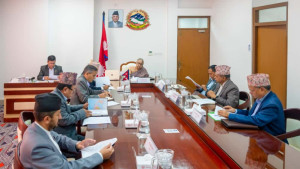Opinion
Looking at logistics
While debating contentious issues, the CA would do well to also keep track of the transitional elements of logistics.
Prakash Bom
Economic viability
It is undeniable that Nepal is a nation of great diversity—multicultural, multiethnic and multilingual. However, the prevailing unitary system of government has failed historically and cannot by virtue guarantee the rights of minorities. Yet, the nation’s diverse population settlement in every district and province suggests that the restructuring of federal states ought to be carried out principally on the basis of economic viability. On the other hand, the delineation of federal states must take affirmative means to recognise identity in order to guarantee rights and equal opportunity to diverse ethnicities.
Hitherto, this contentious issue ought to prompt the main political parties to reconsider their respective stands. For example, UCPN (Maoist) Chairman Pushpa Kamal Dahal, on June 12, attempted to clarify the fact that his party is not attempting to delineate states on the basis of ethnicity. Instead, he affirmed that the state would be restructured on the basis of both identity and economic viability. That’s why it is imperative for all main political parties to present the evidence to address this contentious issue and not let the issue of single ethnicity-based federalism once again prevent the Constituent Assembly (CA) from drafting a constitution.
Form of governance
Fundamentally, federalism is a system that is managed by democratic rules and institutions where the power to govern is shared between national and state governments, whether there is a stronger or weaker central government. Nonetheless, a directly-elected executive head of the national government has been the practice since federalism was first conceptualised as a system of governance where sovereignty is constitutionally divided between central and state governments. Perhaps, except for a few nations like India, where federalism has yet to be fully evolved for citizens of every walk of life to participate in, not just as voters but as contributors to the developments of the nation.
Since the institutionalisation of federalism is imminent in Nepal, a directly-elected executive head of the national government, either under the Parliamentary or Presidential form of government, will make the political system stable and reliable for overall development. Given Nepal’s political heritage, an improved Parliamentary form of governance, as some Nepali Congress lawmakers in the Constituent Assembly are proposing, with a directly-elected executive head of government (the Prime Minister) will be the most viable for federalism. The main political parties ought to consider the political legacy of the nation as well as the stability and reliability that a directly elected head of government can secure for the nation’s development.
Transitional logistics
Besides these two contentious issues, Nepal’s current law enforcement and judiciary systems cannot carry with them their culture of impunity and corruption. These systems must be transformed along with federalism in which law enforcement authorities (attorneys and police officers) and judges are accountable for delivering justice. That is to say, the standard method of appointing attorney generals and Supreme Court judges under federalism must be scrutinised, with a nomination by the executive head of government as per the recommendation of the Cabinet for a Parliamentary Confirmation Hearing Proceedings to complete the appointment. Each state under federalism follows similar proceedings for state Supreme Courts and district court appointments.
Similarly, what will happen to the over 100,000 police personnel if they are not relocated to each federal state? The national government will not have the resources to keep them all. They will have to be relocated on the basis of their electoral constituency. That is to say, he or she will be reposted to that constituency where he or she has permanent residency. The objective of this posting method is to manage local human resources under federalism to maintain law and order in the constituency.
Under the same premise, the thousands of civil service personnel too should be relocated to their posts in the constituency of their permanent residency. This can be at the state, district or electoral constituency level. However, civil service personnel cannot be subsequently transferred from one state to another unless he or she is a federal employee. Likewise, Armed Force Police personnel will have to be relocated in each state as state troopers to guard natural resources and control crimes.
Under federalism, the responsibilities of ministries and departments of the central government are limited in coming up with national policies. Each state implements its own policies and regulates to maintain national standards. For example, the education ministry can make education policies to set national standards but the education department of each state will regulate the educational institutions of that state to maintain the national standard.
Therefore, as much as the contentious issues at the CA, the transitional elements of logistics, which will have to shift from a unitary to federal system, ought to gain significance in the CA for deliberations. The role of the national government and the federal states under federalism must be delineated distinctly because sovereignty is constitutionally divided between the national government and the federal states. As a result, each federal state has the autonomy or right to self-government under the constitution of the nation.
Bom is a freelance writer at the Global Politician, an independent journal of politics and world affairs.




 17.12°C Kathmandu
17.12°C Kathmandu










